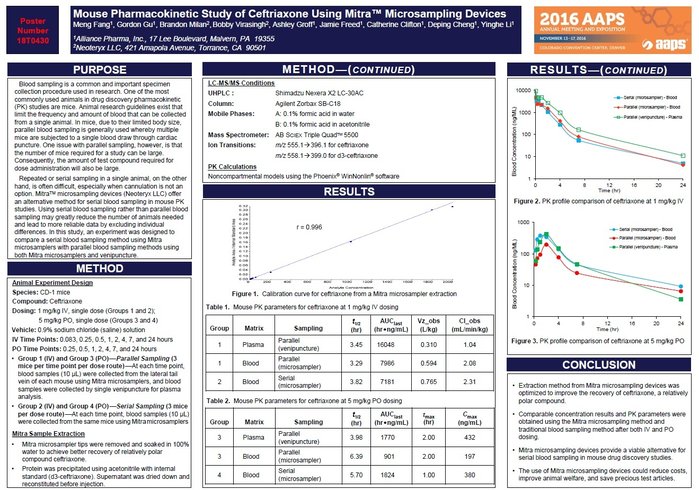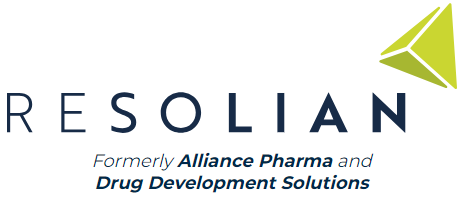Purpose
Blood sampling is a common and important specimen collection procedure used in research. One of the most commonly used animals in drug discovery pharmacokinetic (PK) studies are mice. Animal research guidelines exist that limit the frequency and amount of blood that can be collected from a single animal. In mice, due to their limited body size, parallel blood sampling is generally used whereby multiple mice are subjected to a single blood draw through cardiac puncture. Oneissue with parallel sampling, however, is that the number of mice required for a study can be large. Consequently, the amount of test compound required for doseadministration will also be large.
Repeated or serial sampling in a single animal, on the other hand, is often difficult, especially when cannulation is not an option. MitraTM microsampling devices (Neoteryx LLC) offer an alternative method for serial blood sampling in mouse PK studies. Using serial blood sampling rather than parallel blood sampling may greatly reduce the number of animals needed and lead to more reliable data by excluding individual differences. In this study, an experiment was designed to compare a serial blood sampling method using Mitra microsamplers with parallel blood sampling methods using both Mitra microsamplers and venipuncture.

Method
Animal Experiment Design
Species: CD-1 mice
Compound: Ceftriaxone
Dosing: 1 mg/kg IV, single dose (Groups 1 and 2);
5 mg/kg PO, single dose (Groups 3 and 4)
Vehicle: 0.9% sodium chloride (saline) solution
IV Time Points: 0.083, 0.25, 0.5, 1, 2, 4, 7, and 24 hours
PO Time Points:0.25, 0.5, 1, 2, 4, 7, and 24 hours
•Group 1 (IV) and Group 3 (PO)-Parallel Sampling (3 mice per time point per dose route) - At each time point, blood samples (10 μL) were collected from the lateral tail vein of each mouse using Mitramicrosamplers, and blood samples were collected by single venipuncture for plasma analysis.
•Group 2 (IV) and Group 4 (PO)- Serial Sampling (3 mice per dose route) - At each time point, blood samples (10 μL) were collected from the same mice using Mitra microsamplers
Mitra Sample Extraction
•Mitra microsampler tips were removed and soaked in 100% water to achieve better recovery of relatively polar compound ceftriaxone.
•Protein was precipitated using acetonitrile with internal standard (d3-ceftriaxone). Supernatant was dried down and reconstituted before injection.
LC-MS/MS Conditions
UHPLC : Shimadzu Nexera X2 LC-30AC
Column: Agilent Zorbax SB-C18
Mobile Phases: A: 0.1% formic acid in water
B: 0.1% formic acid in acetonitrile
Mass Spectrometer: AB SCIEX Triple Quad TM5500
Ion Transitions: m/z555.1→396.1for ceftriaxone
m/z558.1→399.0 for d3-ceftriaxone
PK Calculations
Noncompartmental models using the Phoenix®WinNonlin®software
Conclusion
- Extraction method from Mitra microsampling devices was optimized to improve the recovery of ceftriaxone, a relatively polar compound.
- Comparable concentration results and PK parameters were obtained using the Mitra microsampling method and traditional blood sampling method after both IV and PO dosing.
- Mitra microsampling devices provide a viable alternative for serial blood sampling in mouse drug discovery studies.
- The use of Mitra microsampling devices could reduce costs, improve animal welfare, and save precious test articles.
Acknowledgements
Meng Fang, Gordon Gu, Brandon Milan,Bobby Virasingh, Ashley Groff, Jamie Freed, Catherine Clifton, Deping Cheng, Yinghe Li
Alliance Pharma, Inc., 17 Lee Boulevard, Malvern, PA 19355
Neoteryx LLC, 421 AmapolaAvenue, Torrance, CA 90501







